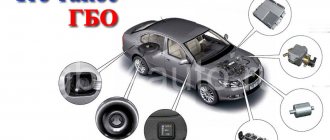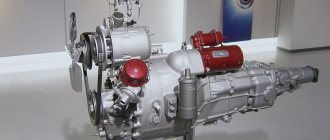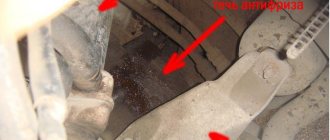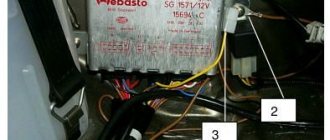Hydronic vs Webasto
When it comes to engine preheaters, the first thing that pops up in the subconscious of most car enthusiasts is the concept of Webasto. This is another heater that is in great demand. What’s most interesting is that it is also produced by a company from Germany.
Therefore, Gidronik and Webasto are rightly considered competitors in the pre-heater market. And in this regard, car enthusiasts have a natural question. They are interested in who is better to choose - Webasto or Hydronic for installation in the engine compartment of their vehicle.
Comparing two heaters is quite difficult. It is almost impossible to draw final conclusions and name a leader. Everyone must decide for themselves which characteristics are a priority and what they can turn a blind eye to.
The comparative characteristics allow us to draw the following conclusions:
- hydronics at maximum power can consume 0.6 liters. fuel for 1 hour of work. At minimum power, consumption drops to 0.2 liters. For Webasto, the figures are 0.51 and 0.26 liters, respectively, which makes the latter heater somewhat more economical;
- Webasto does not warm up the interior space as quickly as its competitor is capable of doing;
- but Hydronic cannot be controlled by the user using a special application installed on a smartphone, which Webasto manufacturers actively boast about;
- in terms of energy consumption and energy efficiency, superiority by a small margin is still on the side of Webasto;
- An important and, for many, key advantage of Hydronic is its maintainability. It will not be possible to restore Webasto functionality if it breaks down;
- Both devices sometimes generate errors and become blocked in conditions of extremely low temperatures. But if Webasto can be manually unlocked on its own, to unlock a competitor you will have to go to a service center.
Many people are surprised by how similar both pre-heaters are to each other. They really have a lot in common, similar characteristics, capabilities, and some of the same strengths and weaknesses.
And they are developing almost in parallel, not wanting to give in to their main competitor in the market of pre-heaters for internal combustion engines.
But you will cease to be surprised by this fact of such striking similarity when you learn one important nuance. The thing is that until recently, when highly efficient heaters began to be produced, the manufacturers Webasto and Hydronic were one enterprise. Then they split up, continuing to produce a device for warming up the engine and interior under their own brands. Hence the striking similarity in the design and operating patterns of the devices.
Taking into account all these nuances, each motorist will be able to draw certain conclusions for himself. First, decide whether to purchase a pre-heater. In reality, not everyone needs it and not everywhere. They are mainly in demand in regions with cold winters, where starting the engine without preheating is really dangerous in terms of wear and negative consequences from constant cold starts.
If you understand that a heater is needed, then you only have to choose between actually two options. Webasto and Hydronic are similar, but there is a certain difference between them, which you already learned about earlier.
It is recommended to entrust the installation issue to specialists. Connecting heaters to the engine, fuel system and liquid cooling system has its own nuances. Installation can be carried out based on the manufacturer's instructions, but in order to ensure correct installation and eliminate possible errors, it will be better if this task is performed by qualified craftsmen.
Important nuances of the warranty policy
The supplier does not assume any obligations for consumables subject to natural wear and tear. This list includes incandescent lamps, candles, pins, fuses, carbon brushes. Those who like to refuel with low-quality fuel and operate equipment in abnormal modes not provided for by the manufacturer will be in for an unpleasant surprise - in this case, they will have to restore the heater at their own expense.
If any components of the product fail despite proper handling and installation, Webasto will repair the product or replace it with a new one. It will not be possible to enrich yourself at the expense of the manufacturer or an authorized dealership by filing claims for lost profits. No matter what moral damage and suffering a thick crust of ice on the windshield in the February frosts causes, no matter what losses the car owner suffers because he was late for a deal due to a broken pre-heater, no one will pay for it. Also, the product supplier will not pay the associated costs of the car owner, for example, the costs of dismantling and new installation of equipment. The liability only covers the device itself that fails.
In some cases, the company is ready to undertake the work of removing equipment and installing it after repair/replacement of the product. In this case, all work will be performed by qualified technicians from a certified service center. But the good will of the manufacturer does not mean the obligation to bear the costs in all cases.
Since the company's engineers are constantly improving the design of the entire Webasto line, the configuration and components of new batches may change. It is useless to try to demand a change if you ordered one modification of the product, but it was discontinued and you were given an updated model.
If a service center specialist promises free repairs within 3 or 5 years after installation, Webasto has nothing to do with this. The entire warranty policy is described in detail on the company’s website; no reservations, additions or changes presented by third parties are valid.
As soon as the owner of the product discovers abnormal operation or breakdown, he should contact the manufacturer or an authorized dealership. You shouldn’t wait for the start of winter; you need to make a written claim and very clearly outline your requirements to eliminate the defects that have arisen free of charge. It should be understood that the warranty period is not renewed or extended, it is also considered from the date of purchase or installation.
The company pursues a balanced service policy, which is why it has remained the leader in sales of preheaters for years. Customer trust is an important part of success in the market, so any warranty repairs are carried out by the supplier or a trusted repair center as quickly as possible. But it is impossible to tell them to the vehicle owner before conducting diagnostics and compiling a list of necessary components.
General scenario for requesting warranty repairs
- The vehicle owner discovers abnormal operation or failure of the heater.
- The owner submits a written complaint to a specialized organization certified by Webasto, or directly to the manufacturer.
- The owner confirms the fact of purchasing the device with documents (receipts, invoices, work orders, etc.) or the presence of the device identification number in a unified database.
- A representative of the company or service center inspects the equipment, draws up a report identifying defects, and compliance of installation and operation with the manufacturer’s instructions.
- The defective component or the entire device is dismantled and sent for diagnostics.
- The optimal way to restore the product by repair or replacement is determined, and the necessary work is carried out.
- The restored/new preheater is returned to the car owner, installation work is carried out (in general, at the owner’s expense).
Reasons for refusing free repair or replacement
If the diagnostics do not allow an unambiguous conclusion to be made about the causes of the breakdown, there is a high probability of improper use of the device, then in controversial situations, warranty service may be refused. The final decision is made by Webasto; the owner’s opinion may be taken into account, but it does not affect the result.
There is a closed list of conditions that immediately deprive the car owner of hopes for free restoration of equipment:
- The owner tried to disassemble and repair the device himself, as evidenced by marks on the body and inside. Intervention by an amateur could cause a breakdown.
- If the product was damaged by a collision with another vehicle or a stationary object, if it was subjected to impacts, there are traces of liquids in it (it does not matter whether the heater was watered or drowned, in any case there will be a failure).
- The device failed due to peripheral equipment, for example, incorrectly working peripherals overheated and melted the port on the heater board.
- Any manipulation of the device serial number will also result in a denial of service, so do not erase, change or delete the serial number. Serial number stickers are also important.
- If damage or cracks are visible on the plastic parts or the LCD screen, this indicates that the device has not been installed or used correctly.
- The product has failed due to external reasons or natural phenomena. If the vehicle was burned in a forest fire, the supplier will not provide a new pre-heater. The same analogies apply to floods, earthquakes, hurricanes, direct lightning strikes and other factors.
- Attempts to save money on installation and incorrect connection of equipment will also lead to failure. The most common errors: lack of grounding, exposure to external electromagnetic fields, the case overheats due to direct sunlight, mechanical destruction from strong vibrations, unstable network connection.
- If the defect occurs due to incorrect connection and installation diagrams, the use of unsuitable materials, or violation of storage conditions, warranty repair will be denied.
There is no need to purchase equipment from your neighbors in the garage; in this case, there is no chance of warranty service. Only purchasing from one of the divisions of the Webasto dealer network will provide support and service. You should also not throw away cash receipts or other documents confirming the purchase. When registering the serial number on the manufacturer's website and installing it in certified service centers, the owner receives a serious bonus - an extended warranty period.
Webasto device
Webasto's design is simple, which is why the device is reliable and never fails. With it you can start any car even in severe frosts. The device consists of the following structural units:
- Combustible mixture combustion chamber. Here the reproduction of thermal energy from the burned fuel occurs.
- Heat exchanger. The device is compact. It is combined with the cooling system of the power unit.
- Automatic control control system - is started by a timer, which is programmed for different operating modes by a remote control (range of action - 1000 meters) or an ordinary mobile phone.
The dimensions of the mechanism are 25/17 cm. It is located under the hood of the car or in the cabin. In minibuses the device is placed under the seat. The basis of the design is the heat-generating part.
Characteristics of the variety
Hybrid varieties combine only the best characteristics of their parents. A vegetable plant such as bell pepper has a huge variety of varieties. Among them we can note the pepper variety Chanterelle f1.
The fruits of the Chanterelle pepper have a compact cone-shaped shape. They are not too large - 25-45 g, glossy, with fleshy walls (up to 5-6 mm thick). When unripe, the fruits are green in color; when fully ripe, they are orange or red. A distinctive feature of this hybrid is that its fruits have practically no seeds.
The taste of this variety is excellent: the pepper is aromatic, the flesh is sweet, juicy and crispy. Due to its compact size, it is ideal for canning whole fruits.
Tips for use
Despite the thoughtfulness of the system and high quality, we must remember that the device burns fuel and releases energy in the same way as a car engine:
- the exhaust is toxic, you cannot use autonomous heaters in confined spaces;
- Only the type of fuel specified in the documentation should be used;
- installation of a fire hazardous device must be carried out by a qualified specialist; these are still changes in the design of the car;
- Long periods of downtime should not be allowed, the heater must be started at least once a month, in this it is similar to a car air conditioner;
- We can recommend installing a separate fuel tank for Webasto, this will prevent possible problems with the compatibility of the fuel preferences of the battery and the engine.
With proper use, Webasto lasts a long time and trouble-free, you can expect an approximate service life of 10 years.
Error codes and diagnostics
Diagnostics of a complex electronic device, such as modern Webasto equipment, must be performed by a specialist. However, the nature of the malfunction can be determined by some of the diagnostic codes read.
Codes are obtained either from the control panel display or through the standard K-line diagnostic interface. In the latter case, you can understand the problem much more deeply using the proprietary Webasto diagnostic program taken online.
It will more accurately reveal these and other faults:
- F02 – the flame goes out;
- F03 – supply voltage is outside the permitted range;
- F04 – fuel pump does not work;
- F07 – fan malfunction;
- F09 – spark plug (pin) failure;
- F10 – overheating;
- F14 – temperature sensor failure.
If the control electronics fail, the diagnostics will also not work; you will have to contact a service center. Although formally there is such an error code.
Installation
Now we will see how to install a heater with our own hands. Mounting can be done both in a new car and in a used one. When driving, you need to take into account some engine features that the former owner should know about. What does the Webasto kit consist of? The working unit comes with an intake, fuel pump, hose, wiring, remote starter, a set of tubes and hoses, and a container for cooled liquid. If you buy a used device, then make sure that the above items are present.
So, the cooling hoses of the working unit should run along the motor. The booster pump is mounted with a special bracket on the fuel tank, and the fuel intake is mounted directly into the tank. A fuel line is placed along the bottom of the car under the hood. The remote control cables must go from the engine compartment to the interior so that repairs can be made if something happens. Installation and repairs at the stage of piping to the engine become difficult. Especially if the pipes are used. For everything to go well, you need to have skills in working with pipes in the engine.
As for the installation of air conditioning equipment, as well as the heating mechanism, this work is also complex. As well as repairs. This is due to the fact that the standard assembly of any machine is made in such a way that all connections, hoses and other elements are placed end-to-end. Of course, installing new hoses will slightly disrupt all the elements. Read the instructions carefully; the developers indicate the recommended location for the hoses. But sometimes theoretical knowledge may not be enough. Therefore, beginners in this business are recommended to buy this equipment and take it to a service center, because repairing the entire propulsion system will be more expensive than 5 sets of Webasto.
How does a Webasto preheater work?
Both air and liquid heaters operate on fuel, which these devices take directly from the fuel tank. The air heater resembles the principle of operation of a hair dryer, in which, instead of an electric heater, a special nozzle is installed to create a torch.
In the case of a passenger or commercial diesel car, such a heater runs on diesel fuel, which it receives from the main or additionally installed fuel tank. Diesel fuel is mixed with air, which is also taken from outside, ignited with a special candle (glow plug or spark plug) and then burns inside a special closed chamber. This chamber is blown from the outside by a fan, due to which hot air enters the car interior.
A liquid heater is a more complex device. As already mentioned, the solution is connected to the engine cooling system circuit. The heater, which has its own fuel pump, pumps fuel from the tank through a separate line. After this, the fuel ends up in a special chamber where it burns. As a result, special ceramic heater pins are heated.
At a certain temperature, the coolant circulation pump is automatically switched on. This pump operates like a standard cooling system water pump (pump), passing cold coolant through the heated heater pins. The heated liquid is then supplied to the engine.
Thanks to this circulation, it becomes possible to effectively warm up all systems of the power unit (cooling system, lubrication system, etc.) After the coolant is heated to a temperature of about 40 degrees Celsius, the standard heater fan is automatically turned on. The result of the work is a warm engine and a warm car interior before the trip.
The entire heating process is fully automated, the number of cycles and heating temperature are set by the user. At the end of heating, the system provides a mode for maintaining the set temperature, automatic or forced shutdown. Some diesel internal combustion engines are equipped with a “lightweight” version of Webasto, which does not have separate controls and is turned on when the engine is running and only when the outside temperature is +5 and below. The purpose of this solution is to maintain the operating temperature of the engine for efficient operation of the standard stove.
Which is better: Binar or Hydronic?
In a number of parameters, domestic heaters are inferior to Hydronic models. At the same time, they are not much cheaper than their competitors. If we consider one of the main characteristics - fuel consumption, then Hydronics are on average 5-10% more economical than their domestic counterparts. Much more noticeable is the difference between the power consumed from the battery and its proven reliability. The “Germans” are ahead here too.
Design and purpose of Webasto
"Webasto" is a kind of stove that functions autonomously, starting its work even before the engine starts. This is a small overall device located in the engine compartment. The unit contains an electronic module that is connected to the on-board network. Activation is carried out by a timer or a special remote control.
The device consists of several components:
- The combustion chamber in which thermal energy is obtained when fuel is burned.
- Heat exchanger. It is a compact system connected to a cooling system.
- Autonomous monitoring and control system.
The main purpose of Webasto is to heat the engine systems, body and interior of the car.
Is Webasto necessary?
Unlike gasoline engines, diesel counterparts are characterized by higher power. They are widely used in passenger cars, commercial vehicles and buses. Despite many advantages, they have a number of disadvantages. At subzero temperatures, the formation of paraffin crystals in diesel fuel is observed, which leads to a jelly-like consistency. Connecting with each other, they form flakes that clog the pores of the fuel filter. As a result, diesel stops passing through the system to the engine, and the latter stops working. Adding additives does not always save the situation, and can negatively affect the engine life of the internal combustion engine. But if we prioritize comfort, then the main problem of a diesel engine at subzero temperatures is its long warm-up time. To do this, special preheaters are installed on the car. Depending on the configuration, its activation occurs remotely or by pressing a button on the device.
Is Webasto needed for diesel?
If you leave your car in a regular parking lot, then in the morning you will experience significant difficulties starting the engine and clearing the windows of snow and ice. The best solution to this problem would be to install a pre-start heater, which can effectively heat the interior of the car in advance even before starting the engine. Purchasing Webasto offers the following benefits:
- Easy start of the motor at any temperature;
- Comfortable temperature conditions in the cabin;
- Increased engine lifespan;
- Fuel savings, since the complex operates autonomously;
- Ability to remotely turn on and off the system.
Operating principle of the Webasto pre-heater
The installation is built into a ready-made vehicle power and cooling system. Therefore, during its operation it uses the same fuel and antifreeze as a car. The heater operates in autonomous mode until the engine is started. In some car models, Webasto is already installed from the factory as an additional heater. To put it into pre-start mode, it is enough to mount additional components and a control element.
Before purchasing the appropriate equipment, you should figure out whether Webasto is needed. The choice of modification directly depends on the type of fuel used in the car and engine size. For car owners who make regular trips, it is better to give preference to equipment with a mini-timer that activates the system at a certain time.
In cases where the car is located close to home, you can choose a remote control. Its range reaches 1000 meters in a straight line. With it, you can program the heater based on the temperature in the cabin. It is worth noting that the installation of Webasto does not affect the warranty if the machine was purchased from an authorized dealer.
Fuel pumping
Before the very first start, it is necessary to pump the fuel. To do this, simultaneously press the two lower buttons – OK and “down arrow”.
The words “H” and “OF” will light up on your display.
Switch to ON.
After this, the pump starts in a jerky manner with clicks. The corresponding icon is displayed on the screen.
To turn off pumping, set everything to OF mode by pressing the down arrow. The first step when pumping is to fill the filter.
Eventually the liquid in the tube should reach the end of the fuel hose.
Pull it and clamp it with a clamp at the corresponding inlet into the stove.
Upon completion of pumping, we proceed to the first launch.
Connection to a gasoline engine
The connection of the device is different on an injection engine and with a carburetor. With the injector it is connected to the ECU controller. In this case, the “ground” is diverted to the body, and the positive wire must be connected to the positive ignition terminal.
The device has two outputs: one goes to the crankshaft position sensor, and the other goes to the ECU. Thus, it will read the number of revolutions from the controller of the control unit. Below is a diagram of connecting a tachometer with BSZ.
Scheme with contactless SZ
Below are instructions on how to connect an electronic tachometer to a gasoline power unit:
- First, depending on the type of device, you need to install it at the place where it will be located.
- Next, the installed tachometer should be connected. The negative wire is usually black and connected to ground.
- The red wire should be connected to the positive of the ignition switch, which is supplied with 12 V when the ignition system (SZ) is operating.
- The third wire can have any color - this is the input of the device. It is connected depending on the SZ. If the SZ is contact, then the device is connected to the distributor breaker; in the case of a non-contact SZ, it must be connected to a voltage switch.
- If the car is equipped with a backlight, the device must be connected to the car's size switch.
Scheme for contact SZ
WHO IS TOSOL
The developers once borrowed the first three letters of the name “Tosol” from a sign above the door of the development department: “Technology of Organic Synthesis” - TOS. And the ending “ol” comes from the chemical terminology used to refer to alcohols (methanol, ethanol, etc.): ethylene glycol is also an alcohol. For some unknown reason, an illiterate opinion has since spread: they say that antifreeze is for “normal” cars, and “antifreeze” is for VAZ cars and others like them... Once again we repeat: “antifreeze” is just one of the types of coolant, but not some special class of chemicals at all! Another thing is that the name has become a household name and is often used when labeling liquids of unpredictable quality. But this has nothing to do with chemistry as a science.
Money issue
As for money, the price of heaters for new and used cars starts at 30,000 thousand rubles. In addition to the basic amount, you can purchase various additional equipment. The price for repairs (that is, installation of this system) will start from 10 thousand. As you can see, installing such a thing on a diesel engine takes a significant toll on your wallet. But this is only at first glance. The used one will cost about 20 thousand. For example, one of the popular models of heaters, Thermo Top Evo 5, costs 40 thousand rubles. The price fully pays for itself within 3 years from the moment the installation took place.
Main advantages
Is it worth purchasing and installing such a unit in your car? Let's note a few advantages of this installation:
- Always a warm interior. With the Webasto autonomous heater, you no longer have to get into a cold car and wait for it to warm up.
- Save time. The system can turn on automatically before your departure - just program the timer or turn on the system via phone 15-20 minutes before the start of the trip.
- Fuel economy. Warming up the interior and antifreeze in the cooling system requires even less fuel than when the engine is idling.
- No ice on the windows. Since the interior will already be warm, the ice crust on the windshield will automatically melt. There is no need to pick it out with a scraper or purchase any chemicals.
- Service life of the engine and attachments. The engine will not start on thick oil, and the starter and battery will last much longer.
Webasto heaters: myths and reality
For most people, a car is an integral part of a busy business life and a faithful companion for relaxing with family or friends. The approach of cold weather forces motorists to think about how to avoid typical “seasonal” problems: an engine that does not want to start, frozen windows, a frozen interior.
Drivers focused on the quality and comfort of car operation know a reliable solution to these problems - installing an autonomous pre-heater. Doubting motorists recall various myths associated with the operation of autonomous heaters. We will try to figure out whether there is truth in them.
Myth 1
The heater drains the battery.
Let's consider the process of starting a car in cold weather. The average battery capacity is approximately 60 A/h. When the air temperature outside is -15C and below, the battery capacity drops by about 15-20%, in fact we get 45-50 A/h. To start a warm engine, about 15 A is required. The current consumption of the Webasto Thermo Top series heater is minimal, and over the entire operating cycle of the heater it is about 1.5–3 A. Approximately 42–47 A/h remains. This is more than enough to start the engine. When starting a cold engine, the resistance and starting currents are much higher, and the starter is more likely to fail when cranked, and engine wear also increases.
The battery density will not be enough to start the engine even if the driver does not use the climate control system of his car correctly - when the standard “stove” is turned on, it “sucks” about 10–15 A. Experts recommend doing this: set the maximum temperature at minimum speed “ stoves”, and also operate the car for at least half an hour after the heater has been operating.
More about Nissan: Nissan X-Trail T31: engine overhaul – Blog
Conclusion: a warm engine requires much less electricity to start than a cold one.
Myth 2
The heater “eats” a lot of fuel.
For the cargo segment, the economic effect of using Webasto heaters is calculated using special programs, where initial data is entered on idle periods, engine idling, diesel fuel consumption, etc. As many years of experience have shown, all heaters reach the payback point after the first season of operation , i.e. for 5-6 winter months. For the passenger segment, calculations are based on the personal experience of each car owner. On average, during a night of operation, an engine with auto-start, when turned on regularly, “eats” about 3 liters of fuel. The Thermo Top heater from Webasto needs to be turned on only once, immediately before the trip, even if the car has been standing in the cold for a month. During a half-hour standard cycle at maximum temperature loads, it consumes only about 200 g of fuel.
Conclusion: the heater and a warm engine together consume less fuel than a cold engine with automatic start.
Myth 3
The heater may cause a fire.
Over the 100 years of the brand’s existence, not a single case of a car fire due to a low-quality Webasto product has been recorded. Webasto heaters meet the most stringent fire safety standards. An interesting fact: at the stand of the manufacturer in Germany there is a heater that has been operating continuously for 40 (!) years - this is how the quality of the alloy from which it is made is tested.
The product is fully certified in Russia and has the approval of the Russian Gosstandart. The reliability of the equipment is indicated in the warranty card in Russian. Problems can only occur if the pre-heater is installed incorrectly. That is why all technicians involved in Webasto installation undergo mandatory training at Webasto Rus LLC every two years. Installers usually display certificates of completion of specialized training near their workplace.
It is important to understand that a certified Webasto product is not only a branded heater, but also its high-quality installation. The company is very attentive to the quality of its product and accompanies it right up to installation, and carries out further diagnostics during operation. Be careful when choosing an installation center. Lists of approved partners can always be checked at the office of Webasto Rus LLC or viewed on the website www.webasto.ru. Lists of “gray” dealers are also published here.
Conclusion: using a Webasto heater is absolutely safe when a certified product is installed in a certified center by trained technicians.
Myth 4
The heater is only useful on very cold days, of which there are few. And in general, my car is in a warm garage, I don’t need a heater.
It is advisable to use a heater from the day when the morning temperature drops below 5C. And even in the European part of Russia there are more than two hundred such days a year, to say nothing of the Ural climate. And even if you park your car in a warm garage at night, during the day you still leave it in the open air - near an office, a store, a restaurant, when you come to visit or go out into the countryside. And in all these cases, the Webasto heater will be indispensable. You can also use the heater in an unheated garage if it is equipped with an exhaust hood. By the way, according to company statistics, more than half of the owners of Webasto heaters have garages.
More about Nissan: Selling Nissan Patrol Y62 2011. — Cars — Club of fans of Infiniti QX, Nissan Armada & Titan
Conclusion: a heater will be useful in any situation.
Thus, the benefits and safety of installing Webasto are obvious. Preheaters create comfort when operating a vehicle in unpredictable weather conditions and significantly save the driver’s time.
For installation in passenger cars, a series of Thermo Top heaters has been developed for gasoline and diesel engines with a volume of up to 2 liters or more. You can get recommendations for choosing and installing a specific model from the official Webasto representative in Yekaterinburg - or from any of the certified dealers.
Note to motorists
The heater does not require routine maintenance, but for preventive maintenance it is recommended to turn it on for 10 minutes every month, including in the summer.
LLC "Webasto Rus" Ekaterinburg, st. Krupnosortshchikov, 14, tel. 379 37 60. www.webasto.ru.
As an advertisement.
Correct installation of the device
How to install an engine preheater? When answering this question, it should be understood that much depends on its modification, however, there are general provisions on this matter
First of all, it is important to remember that the device must be connected to a single-phase network. In this case, its contact must be grounded. This is done using a circuit breaker that has current protection
This is done using a circuit breaker that has current protection.
Also, some advise using a shutdown system when installing equipment. This device will significantly protect the model installation process, and the risk of electric shock will be minimal. Any short circuit in the wiring can lead to a fire. Taking this into account, do not touch uninsulated areas of the equipment during operation.
When starting to install the preheater, it is important to inspect the cooling system. The device must be connected from the cylinder side. In this place there must be a pipe with a diameter of 20 mm
In this place there must be a pipe with a diameter of 20 mm.
Then you should lay the device in a horizontal position. Ultimately it should be below the radiator level. This is done to prevent airing of the device. If necessary, the mounting location can be changed by using an additional hose. As a rule, it is added to the model kit. After connecting the device, it should be fixed to the housing. In some cases this is quite problematic. However, it is considered a gross mistake to fix the pre-heater to the muffler manifold. In most cases, this is unsafe and can cause the vehicle to catch fire.
Conclusion
To get a more clear idea of the heaters of the presented brands, we suggest looking at the table below. It compares three identically powerful models from different manufacturers according to their main technical characteristics. If we compare modifications from the category with lower thermal power, the picture will be approximately the same.
Comparison of Webasto, Hydronic and Binar heaters (gasoline, 5 kW) | |||
| Model name | Webasto Thermo Top Start | Binar-5S | Hydronic III B5E |
| Price range, rubles | 29 950 | 27 800 | 35 000 |
| Fuel consumption, liters per hour | 0,5 | 0,7 | 0,6 |
| Power consumption at maximum load, W | 21 | 122 | 50 |
| Power consumption at average load, W | 12 | 42 | 32 |
| Weight, kg | 2,1 | 2,3 | 2 |
| Overall dimensions, mm | 218×91×147 | 220×85×98 | 215×91×124 |
Based on the table data, the following conclusions can be drawn:
- The price for Binar is the most favorable, Webasto is about 2,000 rubles more expensive, and Hydronic is more than 5,000 rubles more expensive than its analogues.
- The overall dimensions and weight of heaters from the same category are approximately the same.
- In terms of fuel consumption, Webasto is 20% more economical than its opponents.
- In terms of power consumed from the battery, Webasto is 2 times more economical than Hydronic, and 5 times more economical than Binar.
It remains to add to these facts the real experience of car owners. As many years of practice have shown, heaters under the Webasto brand are much more reliable and require less maintenance than competing products.
If we consider only Binar and Hydronic heaters, then the Germans are ahead by a fairly large margin. Although, if you consider that the prices for them and for Webasto are approximately the same, then the question of which engine preheater is better to choose becomes rhetorical.
Electronic engine heaters - 220 V boilers
There is a demand and a lot of offers on the market for electric engine heaters, which heat the coolant and circulate it through a pump. The main representatives of these heaters are Severs and Longfey. A significant drawback of these boilers is the need to connect to a 220 V network, but it finds its application among car owners who use an unheated garage, park the car near their house and pull a carrier. Some craftsmen throw an extension cord from the 2nd and even 3rd floor to the parking lot of an apartment building. However, their price is much lower than that of autonomous heaters.
"Webasto": instructions for use
Despite the similar design and device, each autonomous heater has different instructions and its own separate control method. So, how to use Webasto? The instructions for this heater contain all the necessary information and recommendations for use. The main requirement of the manufacturer is to avoid mechanical shock to the elements of this system. Also, do not expose Webasto to caustic substances or electrical discharges.
In the instructions, the manufacturer writes that the system is very demanding on temperature and air humidity. But, as reviews say, Webasto can be used in absolutely any weather. Well, as for overheating, the system turns itself off when the air temperature reaches the level set by the driver.
What really requires attention is respecting the location where the system is being used. The hair dryer should only be used in open spaces. If the car is in a closed warehouse or garage, similar to the situation with the engine running, there is a risk of suffocation. As we said earlier, this system has its own separate internal combustion engine, and therefore emits exhaust gases during operation.
At a Webasto gas station, just like the ignition on a car, you need to turn it off. Moreover, if the system begins to make a characteristic noise, smell, or even smoke, you should remove the fuse and block it. Here the manufacturer recommends taking the device to a service center for diagnostics. A lot of requirements are stated in the instructions regarding the fuel and coolant used. The manufacturer also recommends performing maintenance on the device during the off-season. It is as follows. Once a month, the system turns on with a cold engine at minimum fan power and operates in this state for about 8-10 minutes. According to the manufacturer, this measure is mandatory. Regular maintenance will help avoid breakdowns during the operation of the Webasto system.
The instructions for use contain detailed information about the rules for operating the heater. The manufacturer does not recommend leaving the system in working condition for more than 1 hour. After this time, you should take a short break (at least 30-50 minutes), after which you can turn on the heater again.
In order to avoid frequent battery discharge after turning off Webasto, it is recommended to leave the motor running for another 3-5 minutes.
It is worth distinguishing between the operating modes of the system. The instructions indicate that the heater operates in 2 modes: winter and summer. In the first case, the system heats up the antifreeze and works as a pre-heater. In the second, Webasto only ventilates the interior, while the cooling system does not heat up additionally.
About Webasto
What is Webasta? In our country, Webasta is usually called the pre-heating of the PZD engine, or an independent cabin heater. In fact, this is a German manufacturer of automobile independent (autonomous) heaters and other automotive systems "Webasto". Along with this manufacturer, another German manufacturer produces autonomous heaters. And of course, “Autonomous heaters and preheaters” are produced in our country: The Advers plant in Samara has “Planar” and “Teplostar” In Shadrinsk, “SHAAZ” EltraThermo from Rzhev has “Pramotroniki” ”Grown from the Shperos technology and brand purchased by Russia from Webasto: and others abroad. There are autonomous heaters. Autonomous heaters are used to create a warm climate in the car and preheat the engine in particular. Moreover, they work autonomously, i.e. they do not need either a motor, or a 220V street outlet, or even driver control and actions. Autonomous units are called dry and wet, pre-heaters and after-heaters, hair dryers and hydronics, there are diesel, petrol and gas ones. According to their purpose or type of coolant, there are: – Engine heaters – Interior heaters – ICE heaters – this is a “hot water boiler” that heats the coolant Antifreeze, Antifreeze (coolant).
They are distinguished into Pre-heaters and Pre-heaters.
only works in conjunction with internal combustion engines. (they do not have their own water pump). They are usually installed standard on diesel cars in order to quickly warm them up to operating temperature immediately after starting the engine. (If you have the knowledge, you can convert it into a pre-launch one).
- Preheater
can work both together with the engine and without it - to warm up the internal combustion engine before winter start-up. Quickly warm up the engine after starting it, and even automatically warm up the car's cabin. This is a stove that heats the air in the car’s interior, regardless of the operation of the car’s engine. Can be used while parked and while driving on the road. They are also called “Hair Dryers”, “Blowers” and “Dry Autonomous Units”. Selecting an Autonomous Unit Cabin heaters are distinguished by power depending on the volume of the heated room:
- – 2 kW is used for ordinary cabins (KAMAZ + sleeping bag).
- – 3-4 kW – large cabins (American).
- – 5-8 kW – motorhomes, kungs.
Preheaters differ in the volume of coolant (coolant) in the internal combustion engine (engine), but since this parameter is rarely used, they are distinguished by the volume of the combustion chambers (in liters (aka cubic centimeters)):
- – 4 kW – internal combustion engine up to 2.5 liters (most cars with power up to 150 hp (horsepower))
- – 5 kW – ICE from 2.5 to 6 liters (Jeeps, minibuses with a power of more than 150 hp)
- – 9 kW and above – internal combustion engine more than 6 liters (all commercial vehicles, multi-seat buses).
Below you can download the method for calculating the thermal power of the heater. Why do you need autonomy? Autonomous interior heaters are an absolute attribute of all truckers, hunters and fishermen. The hair dryer operates almost silently; consumes little fuel and electricity; and independently maintains the temperature set by the driver. Calculating the fuel consumed during the parking of the internal combustion engine or autonomous vehicle will show the payback of Webasto, etc. in a month or two. In addition, for modern highly loaded diesel engines, prolonged idling while parked is harmful. For any internal combustion engines (internal combustion engines), the most painful thing (kills resource) is a dirty air filter and cold start. One cold start is equivalent to 500 km of car mileage.
On winter roads, the peak of accidents occurs at the beginning of the movement - the windows are frozen or fogged up and movement is constrained by warm clothes.
An autonomous engine heater that starts up independently before your trip will warm up the internal combustion engine and even the windshield and interior with warm air in 20–40 minutes of operation. You can launch Webasta while you are drinking tea at home. By calling the phone, pressing the button on the alarm key fob, WEBASTO key fob, or by setting the start time on the remote timer earlier. And now you no longer need to “dance with a tambourine” around a frozen car that won’t start. We started the engine and immediately hit the road. Cons of Webasto But there are 2 big disadvantages: This is the price, and the discharge of the battery (car battery). A used, serviced boiler eliminates the first problem. Discharging the battery: To avoid problems with a dead battery, of course it must be known to be in good working order and fresh (batteries that have been in use for more than 5 years are already considered “super batteries”). Keeping track of your battery is quite easy. Batteries do not like prolonged parking in cold weather, short trips, being kept in the mud without being secured under the hood, and malfunctions of the vehicle’s on-board network.
In winter, before starting the car, be sure to take a look at the standard voltmeter, or install an additional one.
The voltage at the terminals indicates the condition of the battery.
12.7 V Good (100%)
12.6 V Normal (90%)
12.5 V Weak (70-80%)
12.2 V Discharge (0%)
These readings should be measured with consumers turned off, and no less than seven hours after stopping the internal combustion engine. When using battery power, you need the engine generator to charge your battery twice as long. If you drive to work for 40 minutes, the heating works for about 20 minutes. Otherwise, charge the battery with a charger once every two weeks. Technical characteristics of Webasto and Eberspacher heaters and calculations for selecting the power of autonomous heaters can be downloaded below:
Electric interior heaters for 12 and 24 V
Until recently, almost all electric interior heaters had a spiral design.
Today, most devices are made using ceramics.
The advantage of this product is its oxygen-saving properties, which allows you to maintain the air quality in the cabin and not “dry” the air.
The ceramic heat fan can be powered by 12 or 24 Volts, it quickly warms up and heats the room.
The main advantages are efficiency, protection against overheating and falls, compactness and lack of interference when driving.
Electric interior heaters are lightweight (up to 500-800 grams), which allows the product to be transported to any necessary place (to the garage, to a parking lot, and so on).
The only drawback for many of them is the high cost, but if you wish, you can choose a device that suits your own pocket. Here a lot depends on the manufacturer and power.
1. For passenger cars.
Autonomous heaters for this type of car are represented by a whole group of high-quality models.
Here are some of them:
Calix Slim Line 800W is a very powerful device that can heat the interior of a compact car in a short time. The device is equipped with a switch that allows you to adjust the car to the current climatic conditions. The heater has thermal protection, which prevents erroneous operation (for example, when there is no air flow from the street). Calix Slim Line 800W is a high-quality heater with a high level of safety. Warranty - 3 years.
ZNICH PFJ is a heater for the passenger car interior, operating on 12 and 24 Volts. The device is intended for passenger cars with a small interior. The advantages of the device include the ability to adjust the temperature, compactness, ease of installation, and durability.
2. For trucks.
Airtronic products are in great demand on the market of autonomous heaters for trucks.
Here we can highlight models D2-D5, which are distinguished by their unique power and are designed for heating various vehicles, from commercial vehicles to yachts.
The devices are powered by 12/24 Volts, are affordable and highly efficient.
Such heaters show high efficiency even with frequent door openings (for example, in public transport).











